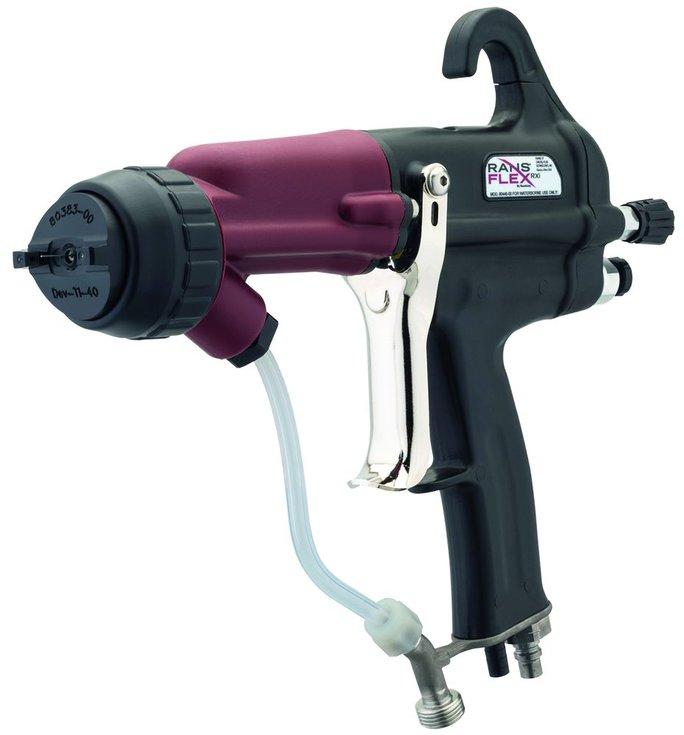Electrostatic Spray Gun features Devilbiss air cap technology

The new electrostatic paint spray gun ‘RansFlex RXi 45kV’ of Ransburg uses indirect electrostatic charging technology which means that there is no longer any need to isolate the waterborne paint feed containers or paint pumps with expensive isolation cages or tanks. This saves costs and floor space. In addition, the design of the spray gun combines the air cap atomization technology of Devilbiss with the electrostatic features of Ransburg.
Contents
Principles of Electrostatics
The basic principle of electrostatics is that same-charge electrical particles repel one another and unlike electric charges attract. And the unlike charges are used in the electrostatic painting process: small particles are introduced into a high voltage corona discharge. The particles accept the electrostatic charge. And when these charged particles are permitted to move, they will travel to the nearest grounded surface.
Introduction – Electrostatic Wet Spray Painting
The advantage of Electrostatic Spraying is the savings in material by placing a high voltage electric charge on each atomized particle of paint. The object to be coated is an electrically conductive ground. Some of the paint particles, which would normally miss the painting surface, will now be attracted to the edges and back side of the work. This effect is commonly referred to as the ‘wrap around’ effect.
Electrostatic Disc System
One method is to use the electrostatic force created by a high voltage differential between a paint dispenser and the grounded work. These are available in either automated or hand held systems. This force tears the material apart creating atomization and deposits the material on the object to be coated (no air or hydraulic force is used). This method is also sometimes referred to as ‘true electrostatic painting’. The material is fed to a rotating disc and a set speed will cause the material to flow by centrifugal force to the edge, but not disperse. The disc or bell is charged to about 120,000 volts D.C. Negative (excess of electrons). As the object to be coated passes by the rotating disc, the material is pulled off by a current exchange between the emitter and the product and is attracted to the work. This type of electrostatic finishing is commonly used by appliance manufacturers because of the high production and uniformity of coatings on the parts to be coated.
Electrostatic Rotary Bell Atomizer
Rotating bell atomizers (SYNO: rotary applicator) operate at speeds between 20,000 and 70,000 RPM and are designed for automation (robotic spray process). The central component is the bell cup that comes in different sizes. The coating material to be sprayed is supplied to the center of the cup and under the influence of centrifugal force it is spread over the inner surface of the cup and is atomized on its edge. The greater the speed of rotation, the finer and more homogeneous is the resulting spray. However, the atomization of material does not result in effective deposition on the work piece without the electrostatic field. Here air ports (SYNO: air caps, air cover) concentric with the bell cup serve both to control the atomized particles in the electrical field and to aid in establishing the diameter of the cone of atomized paint particles.
Air, Airless and Air-Assisted Airless Electrostatic Paint Guns
Another method is to use air as the atomizing force. This system is designed to use air, airless, or air-assisted airless atomization principles. The spray gun can be hand held or automatically operated depending on the requirements. The high voltage charge (about 75,000 volts) is induced, via an electrode that is usually placed inside the spray gun, into the spray pattern and adds an electrostatic charge to the atomized material particles. The attraction between the atomized particles and work is strong enough to bend the overspray around the product depositing most of the material on the back side of the work piece.
The high voltage at the needle tip will vary depending on the amount of current being drawn through the circuit. The more current that flows through the circuit, the greater the voltage drop at the needle tip. In order for a ‘wrap-around’ effect to be present, it takes an elevated voltage of 30 kV or more for this to happen.
Electrostatic Paint – Material Considerations
Material used in such electrostatic systems should be formulated so that the paint resistance be within the suitable operating range. If the amount of current drawn is greater than 105 milliamps, for example for electrostatic air spray guns, then the paint is too conductive and will show little or no wrap effect.
When the equipment is operating properly and the paint conductivity is low, a ‘wrap-around’ effect is present. If a weak or no ‘wrap-around’ is present, the paint conductivity may be too high. When using automatic spray guns with this system, all material can be sprayed. Materials that are conductive will electrify the material supply and therefore it will be necessary to isolate the fluid supply from the electrical ground. When these ‘hot’ systems are used, precautions must be taken to avoid physical contact with the material supply.
